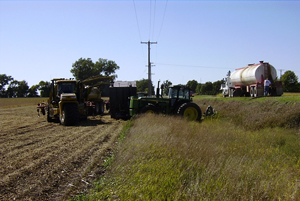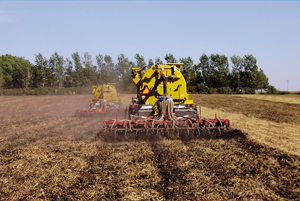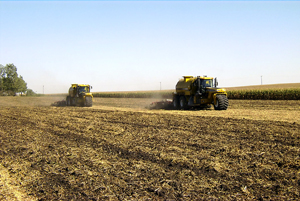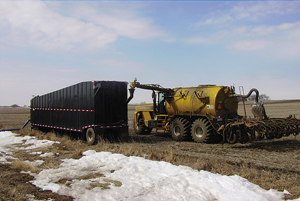
Iowa’s Midwest Farmers Co-op has
gone into manure management in a big way, offering customers a one-stop
shop for professional manure application services, using Terra-Gator
equipment.
Iowa’s Midwest Farmers Co-op has gone into manure management in a big way, offering customers a one-stop shop for professional manure application services, using Terra-Gator equipment.
This won’t come as a secret to Iowa farmers, but it takes a pile of nutrients to grow those bin-busting crops of corn and soybeans. Last year, according to Iowa’s Feed and Fertilizer Bureau, the state’s sodbusters applied more than four million tons of fertilizer. That’s four million tons of inputs buffeted by the ballooning costs of energy and freight, and the up-and-down fortunes of the US dollar.
But what if some of that fertilizer could be displaced by a homegrown product, one that’s manufactured on the farm by Iowa livestock? What if the high-tech application of manure could offer an economical, environmentally beneficial option for farmers?
 The crew at Midwest Farmers Co-op operates three Terra-Gators and the The crew at Midwest Farmers Co-op operates three Terra-Gators and the co-op is considering adding a fourth unit to the fleet. “The Terra-Gator 9105 has big horsepower,” says the co-op’s Larry Den Hartog. |
That was the light bulb that went off in Larry Den Hartog’s head. Den Hartog is operations manager for the agronomy division of Midwest Farmers Co-op in Sheldon, Iowa, and he saw the potential for a service offering high-tech application of liquid manure. Now, almost five years after the co-op started its custom manure injection service, dozens of customers are taking advantage of those benefits, too. “We’re using manure as an asset, rather than a waste product. It’s a fertilizer asset,” says Den Hartog, who combines manure and soil analyses with GPS technology to meet crop requirements.
“Rather than just dumping the manure out there, we’re using it over more acres, and demonstrating the value of it. This is a fertilizer that’s already here. It’s stuff we don’t have to transport from Florida or Canada.”
Custom manure application isn’t a new idea for the northwestern Iowa co-op. The co-op operates a 4,000-head, custom-finished beef feedlot to serve its members, and it used to spread the feedlot’s manure on a custom basis, using a tractor and tanker.
After opting to hire other custom operators to look after the feedlot manure, Den Hartog saw the opportunity for a new, revitalized manure-handing service, one that would operate within the co-op’s agronomy branch. “I thought, what if we got back into it? And this time, we go into it big time.”
Going big time meant moving from the tractor-and-tanker approach in favor of a system that analyzes the manure’s nutrient value and applies it to the field at a variable rate. To survey the state of the art, Den Hartog scouted high-tech manure application systems in the Netherlands. When he returned, he adapted the European approach to Iowa conditions, applying liquid manure from beef feedlots, swine operations and dairies, and serving customers ranging from large-scale cash croppers to 80-acre part-time farmers.
The backbone of the operation is Ag-Chem Nutrient Management System’s Terra-Gator 9105, a five-wheel, 400-hp behemoth equipped with a 4,450 US-gallon tank. Part of the AGCO farm equipment company (which also includes such lines as Massey Ferguson and Cleaner) Terra-Gators are built in Jackson, Minnesota, just north of the Iowa State line.
 The Terra-Gators are equipped with Ag-Chem’s Falcon II Controllers, The Terra-Gators are equipped with Ag-Chem’s Falcon II Controllers, on-board computers that use GPS technology to guide the machine and apply manure to meet the agronomic prescription for crop growth. |
Den Hartog’s crew operates three Terra-Gators, and is considering adding a fourth to the fleet. The 9105 “is a good unit, and it’s got big horsepower.” Midwest plans to trade the co-op’s oldest Terra-Gator for a new unit in autumn, 2006, when it will have about 6,000 hours on it. “I can’t afford downtime,” Den Hartog says.
The “brain” of the Terra-Gator is Ag-Chem’s Falcon II Controller, an on-board computer that uses GPS technology to guide the machine and apply manure to meet the agronomic prescription for crop growth. The controller applies manure at either a flat or variable rate, and produces maps to show the landowner where and how much manure was
injected.
Typical injection rates for Midwest customers range from 1,200 to 6,000 gallons per acre, although Den Hartog’s team has injected up to 10,000 gallons per acre. “What I like about it is you can dial up exactly what you want, and that’s what the Falcon II gives you,” he says. “You also get an excellent reporting system out of the Falcon. You get the time of day, the rate of application—everything you need.” The Falcon’s thorough reporting not only keeps customers happy, it helps the co-op and its customers meet Iowa’s increasingly stringent nutrient management regulations.
The most common use for the manure is supplying the bulk of the nutrients for the region’s corn/soy rotation. “With corn/soy, the beans like the second-hand P and K, while corn takes advantage of the N applied during the first year. Around here, most farmers fertilize for the corn, and the beans have to make do with what’s left over.”
The co-op integrates manure and commercial fertilizer application. “If the manure doesn’t satisfy the potash needs of the crop, we go over the field again with a Soilection machine and top the potash up to meet our recommendations,” says Den Hartog.
Manure for corn/soy land is injected with a Kongskilde Arable Land Injector. The 18.5-foot tool bar uses a series of sweeps to shatter the soil between three to six inches in depth, while leaving most of the surface residue in place. Manure is injected at about six inches to ensure incorporation and limit nutrient loss and odor. The bar does such a nice job that Den Hartog says some customers plant directly behind it.
To diversify the application service—and pick up more work during the slower summer season—the co-op also injects manure into alfalfa using a 21-foot Veenhuis grassland bar. The bar uses a disc opener that cuts a 1.5-inch-deep groove into the soil and injects manure in 7.5-inch widths. The bar—and its associated yield gains for forages—has made a positive impression on customers, and Den Hartog says grassland injection has become increasingly popular.
One of the co-op’s satisfied clients is Garry Korthals. He operates a 4,200-head swine nursery and cash crop operation near George, north of Sheldon, and has hired the co-op to apply the manure from his deep-pit liquid manure system.
With all the work involved in caring for the pigs, “I had a hard time keeping up with everything,” Korthals says. So rather than spread the manure with his own tanker, he hired Midwest Co-op.
The payoff has been dramatic. “The fertilizer bill has come way down,” Korthals says. “I’m not only picking up most of my N, P and K from the manure, but I’m also picking up micronutrients, including sulphur and zinc.”
Because Midwest injects the manure on a variable rate, uses precision technology and supplies a full agronomic report with maps, Korthals has the peace of mind of knowing the manure was properly applied in an environmentally responsible manner.
“You know you’re not getting too much phosphorus on there, so the DNR (Iowa Department of Natural Resources) won’t get after you,” he adds. The other plus of using the manure to meet the basis of the crop’s needs is it cuts the amount of commercial fertilizer needed for top dressing. “You’re only buying as much commercial fertilizer as absolutely necessary.”
 Midwest Farmers Co-op applies liquid manure from beef feedlots, swine operations and dairies, serving customers ranging from large-scale cash croppers to 80-acre part-time farmers. Midwest Farmers Co-op applies liquid manure from beef feedlots, swine operations and dairies, serving customers ranging from large-scale cash croppers to 80-acre part-time farmers.
|
Midwest supplies its clients with a report on the manure’s fertilizer value and the equivalent cost of the same nutrients in commercial fertilizer. In 2003, for example, Korthals paid US $44 per acre to ship and apply 4,000 gallons of manure with a nutrient value of 166-87-138. If he’d applied the same nutrients using commercial fertilizer, the cost would have been $81.51 per acre.
Another plus that’s tougher to account for, at least in dollars and cents, is the impact of additional organic matter and increased microbial action in the soil. “Every year you can see more benefits to it,” Korthals says. “If I was to do it myself, I wouldn’t be able to get the full benefit out of the manure.”
For Den Hartog, the challenge lies in satisfying individual customers, and still moving enough volume to make the service pay for itself. On the one hand, the use of precision technology provides a focus on individual farms and fields, while an extensive investment in larger machinery allows Midwest to move a lot of manure quickly and efficiently.
In terms of individual service, the co-op offers one-stop shopping for manure handling and application. “We’ll take care of brokering your manure if you don’t have your own land to put it on,” Den Hartog says. “If you do have your own land, we’ll grid sample it to determine your requirements, and we’d apply the manure at a variable rate to meet those requirements.”
The co-op samples the manure to get a reliable average of the nutrients involved, typically taking a sample from every other load applied. Iowa has tough regulations to limit the over-application of phosphorus, and nutrient management plans restrict nitrogen application to the annual needs of the crop in the field.
For new customers, the co-op usually begins with a single-rate application, graduating to the more-costly variable rate approach as the manure becomes a known quantity. “I like to have a good three-year history of the pit before I go with variable rate. You want to know that the nutrients are consistent.”
At the pumping site, the crew uses Houle pumps to drain the pit, either pumping directly into a tank that acts as a reservoir for the Terra-Gators, or filling tanker trucks for journeys to more distant fields.
 The in-field reservoir for the Terra-Gators is a 21,000 gallon “frac” tank, originally used in the petroleum industry. The in-field reservoir for the Terra-Gators is a 21,000 gallon “frac” tank, originally used in the petroleum industry. |
The co-op runs up to nine tankers, each carrying about 6,000-7,000 gallons. The in-field reservoir is a 21,000-gallon “frac” tank, originally used in the petroleum industry and purchased used from Oklahoma-based Wade Industries. The tank, in turn, feeds the Terra-Gators.
On big jobs the Terra-Gators work in tandem using a Trimble light bar, the first setting the A-B line along the edge of the field, and the second following it, with each machine alternating passes. On distant fields, all nine trucks may be needed to supply the tank and keep the Terra-Gators rolling.
“Ten miles is about as far as you want to go (from the manure source) because freight costs start piling up. We deal with a lot of gravel roads, it’s hard on trucks. `Right now the roads are soft, so we don’t really make anything on freight,” Den Hartog says. To cut freight costs, the co-op brokers deals to swap manure with nearby farms, in order to draw manure from a pit closer to the field.
The service employs about a dozen full and part-time workers, and operations peak during the autumn. “We run hard for 60 or 70 days in the fall,” Den Hartog says, adding the light bar-equipped Terra-Gators fire up before dawn, and shut down long after dark. Potential changes to the system include the addition of another Terra-Gator, and an extra frac tank, so one can be pre-positioned while the first is still in use.
Making the most of Iowa’s manure doesn’t mean the state will stop bringing in commercial fertilizer. But the precise application of manure means the state’s farmers can make more productive use of homegrown nutrients, save on the fertilizer bill, and ease environmental concerns.
And for Midwest Co-op, the manure operation isn’t just a valuable service, it’s a growing business. From last September 1 to this April 1, the Midwest crew applied more than 46 million gallons of manure.
“I had to have 40 million gallons a year to break even, so we’re very happy with the way the program is going,” says Den Hartog. “We’ve probably got 25 percent (of the market), and I have a waiting list of 40 or 50 people who want manure. We never have to go ask people to take it—we’re turning people away every day.”